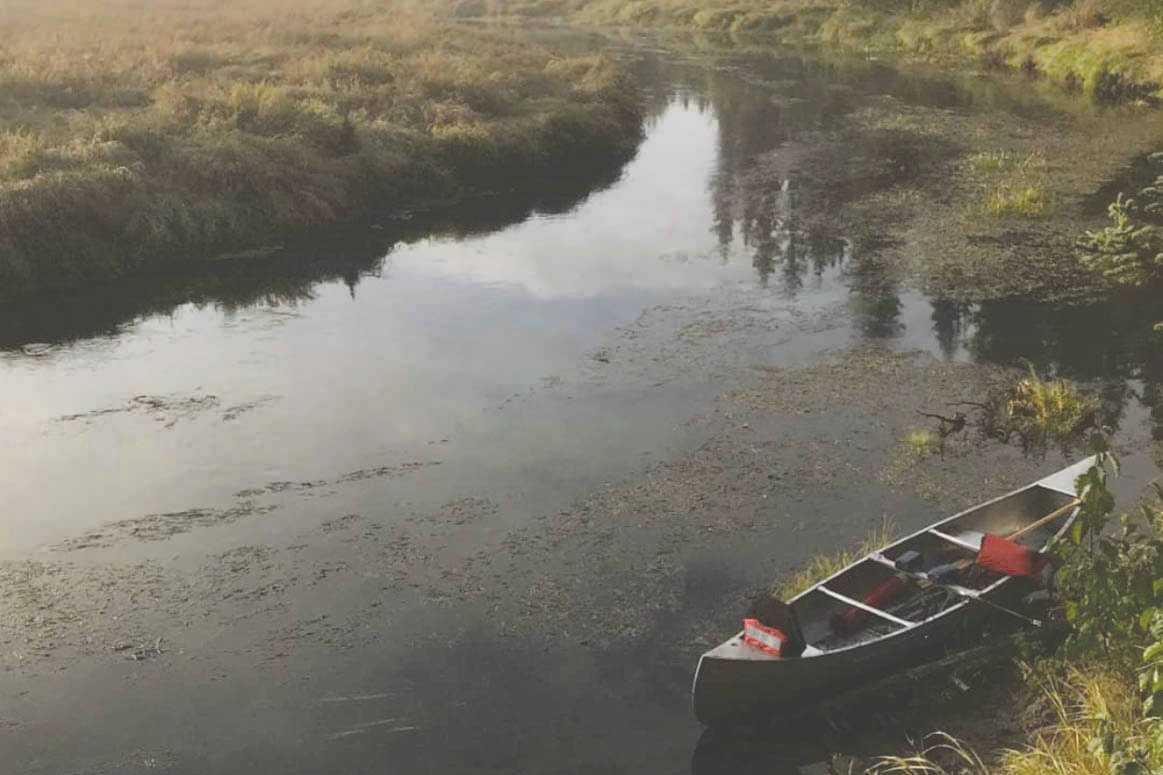Rain pounded against the windshield, encouraging a creeping melancholy as I drove myself and a volunteer north on the Sterling Highway toward Swanson River Road.
This week my task was to float a section of the Swanson River extending 24 miles from the interior Kenai Peninsula to Captain Cook State Park on Cook Inlet. I needed to enlist a volunteer to help me paddle the canoe.
A friend who wanted to float the Swanson River, but had never paddled a canoe before, joined me. Our mission was to cut and remove any trees that had fallen across the river and pick up any trash we found in vacant camping sites.
Easy! Sounded like a fun way to spend two days of work!
We turned off the Sterling Highway and began our trip down Swanson River Road, leading to the river put-in where we would begin our voyage. Halfway down the 17-mile dirt road, a tire on our truck was punctured and deflated before I was able to pull the truck to the shoulder of the muddy road. A fine start to an epic journey!
We were soaked after changing the tire, blasting the heat for the remainder of the drive. Our wet, muddy clothes eventually dried and we reassured ourselves that we would still enjoy this trip.
The rain did not let up while we put our aluminum canoe into the river that morning, nor did it relent as we paddled the first 16 miles. We stopped on multiple occasions, primarily to dump rainwater from the boat.
For those who have floated the Swanson River, you may know that there are many large rocks near the surface of the water. The dark, overcast sky and raindrops rippled on the surface of the water, obstructing our view of upcoming underwater obstacles.
We quickly perfected the art of untangling ourselves from these rocks, only to strike more a short while later.
Every few miles we would stop to cut impassible trees that had fallen across the river. We would stop to walk through frequently used camping sites to collect trash left behind by those who had not learned that this wild place was not one where they should leave their waste.
The amount and variety of trash we gathered from these camping sites was impressive, weighing over 80 pounds. Aside from the expected waste such as small pieces of paper and plastic, we collected broken camping chairs, chewed up XTRATUF boots, soiled clothing, a toilet seat and a candlestick traffic cone.
Our enthusiasm began to diminish as the late September sun sank lower in the sky and the rain continued falling in sheets. We sought, and eventually found, a suitable piece of riverbank to land our craft and camp for the night.
With our work duties for the day complete, we focused on setting up camp, getting ourselves into dry clothes and cooking a warm meal. Tonight’s menu was veggie dogs cooked over an open fire as we huddled under a tree to keep dry.
Voilà, bon appétit!
There is truly nothing like the feeling of comfort achieved by transitioning from wet, cold, hungry and on-the-clock to warm, dry, satiated and clocked off.
We smothered the fire, hung our food in a tree and set out our wet clothes in an attempt to dry them. I can’t speak for my counterpart, but I slept like a rock that night.
Upon waking the next day, I noted the bright light coming from the east and the absence of the pitter patter of raindrops on the tent rain fly. That was a good sign. I didn’t recall any sunshine in the forecast.
When I stepped out of the tent, before me was a magnificent view of an oxbow bend in the river that perhaps I was too tired to notice the previous day. Rays of sunlight filtered through low-lying fog and the birds were singing. Glorious sunshine!
I strung a clothesline out to dry our wet uniforms while we packed up camp and ate breakfast. All the while we were basking in the sun and cracking jokes about our conquest over the previous day.
Once on the river again, we cheerfully carried out our work duties, cutting a few more trees and cleaning some more camping sites. The hours seemed to fly by as we completed our work on the river that day.
Navigating around the submerged boulders was much easier in the bright daylight than it had been yesterday when it was overcast. We even saw numerous spawning silver salmon swimming against the current. Our egress to the truck we had waiting for us at Captain Cook State Park was pleasant.
I am sorry to report that I received no philosophical breakthroughs upon completion of my trip down the Swanson River. There was only water, rock, forest and the way downstream. My co-worker and I were not awarded any special accolades for paddling through the pounding rain, except for a beautiful second day of floating in the sun.
There was, however, perspective — I can promise you that. The only way to see for yourself is to go into this remarkable wilderness.
Kasey Renfro is in his second season at Kenai NWR. Mr. Renfro is an experienced trail crew member and has worked in many different public land areas where we constructed and maintained public use hiking trails. Find more Refuge Notebook articles (1999–present) at https://www.fws.gov/refuge/Kenai/community/refuge_notebook.html.


